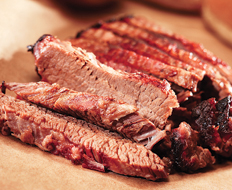A great way to start an argument is to talk about America’s best barbecue. It’s a dispute that won’t be resolved.
“A lot depends on where you were raised, because you get an emotional allegiance to one particular type of barbecue,” says Peter Reinhart, chef on assignment in the College of Culinary Arts at Johnson & Wales University’s Charlotte, North Carolina, campus.
“You are tapping into the heritage—the cultural identity—of a region or town,” he adds. “The meat, the mechanism for cooking, all have their proponents. If you can divorce yourself from the emotional side, you can enjoy it all.”
The disagreements extend to barbecue’s ancestry. Reinhart says American barbecue styles go back to the Caribbean islands and Native American cooking techniques.
There are even tales about pirates bringing barbecue to South Carolina’s ports in the 16th century, he says. One frequently cited view on its history is that barbecue is derived from baribicu, or “sacred fire pit” for some indigenous Caribbean peoples. The pit cooked small game on a wooden stand.
This wasn’t unique. Etchings of Frenchman Jacques le Moyne’s mid-1500s drawings show Native Americans cooking similarly. One depicts natives roasting small prey on a platform enveloped in smoke from the wood fire below.
“It’s cooking on low heat for a long period of time … with flavor from the wood,” says Lake High Jr., president of the South Carolina Barbeque Association (SCBA), who offers a brief history of barbecue on the SCBA website.
Spanish explorers, who introduced pigs and other animals to the New World, renamed this barbacoa. Later, barbecue became the English word.
By the 20th century, barbecue had become a catchall term for a wide range of cooking styles, from using an earth or stone pit—something done worldwide for millennia—to quick backyard grilling of small pieces of meat over hot coals and flames. But real American barbecue involves slow-cooking meat over low heat, creating flavor-enhancing smoke with at least some burning wood or charcoal. It takes time to learn how to do this well, even with modern gas and electric pit smokers.
“You can go from A-plus to F barbecue quickly,” says Roland Dickey Jr., president of Dallas-based Dickey’s Barbecue Pit, the nation’s largest limited-service barbecue chain. “As much as we may try to turn it into science, it’s still very much an art form.”
Most experts believe the cradle of ’cue is the Carolinas, where whole-hog cooking evolved over centuries. There are at least three other widespread American styles: Memphis, Texas, and Kansas City. The differences among regional styles are the sauces and types of meat.
“It’s not like barbecue is patented,” says Dan Huntley, who grew up watching pit masters preparing barbecue the old-fashioned way and now owns Dan the Pig Man food truck in Charlotte.
The barbecue tradition of cooking whole animals over wood coals continues today at some special events and restaurants. But at most eateries, barbecue is usually from a cut of meat—primarily pork shoulders or beef brisket—or entire chickens.
Huntley says modern barbecue developed from meals eaten by the poor. “The rich were eating high on the hog,” with the best cuts from the back and upper legs, he says. “The poor … got the inferior cuts. They had to tenderize it, so they used the two things they had an abundance of: time and wood.”
For the best Carolina barbecue, the pork should be cooked north of 12 hours at about 195 degrees, which is when the collagen breaks down and the fat is rendered out, Huntley says. The meat becomes tender and can be pulled apart; pulled pork is at the heart of Carolina barbecue.
Eastern North Carolina–style ’cue is still often made from whole hogs. The meat from all parts of the pig is mixed and often finely chopped so the crunchy skin, or cracklins, will be part of each bite. The sauce is a thin vinegar and pepper mix.
Among the great eastern North Carolina joints is the 65-year-old Skylight Inn in Ayden.
Here, barbecue is a craft. There are no temperature gauges in the cookhouses, where “we cook over wood the way our family has done since the mid-1800s,” says Samuel Jones, a grandson of the original owner.
Dressed pigs are placed on rods in the pits, where they are cooked for 14–16 hours with heat provided mostly by oak wood, giving the meat a mild smoky flavor. After pulling the pork, “just enough” of a light vinegar and pepper sauce is added to keep the meat moist while being chopped, Jones says. “We want people to taste the time and energy.”
Barbecue sandwiches are $3.50, with or without Skylight’s sweet coleslaw. Platters of barbecue, slaw, and cornbread start at $5.50.
A modern take on Eastern North Carolina barbecue is found at Smithfield’s Chicken ’N Barbecue. Founded in 1964, the Smithfield, North Carolina, business now has 14 company and 20
franchised units.
“In eastern North Carolina, vinegar is the signature sauce item,” says Richard Averitte, director of operations and marketing. Smithfield’s sauce has vinegar, red pepper, and salt.
Pork shoulders are cooked slowly overnight at low heat in electric ovens without wood. When done, the meat is hand pulled by managers or experienced staff.
“We have two meats—[pork] barbecue and fried chicken—and four sides. Our managers are trained to make those very well,” he says. Pulled-pork sandwiches (about $3) are served with or without slaw on top, and platters with two sides are $6.39.
West of Raleigh, barbecue takes on a different flavor. Named for the small-but-restaurant-rich town, Lexington-style barbecue consists of pork shoulders with a vinegar-tomato sauce.
Smokey T’s in Trinity, North Carolina, cooks pork shoulders 14 hours in a gas smoke room using hickory wood. “When we get them out, we nudge them and the meat comes right off,” says co-owner Mike Tucker. The vinegar-tomato sauce is then added.
South Carolina echoes the styles of its northern neighbor, but has a third sauce: a yellow mustard variety that includes vinegar, brown sugar, and spices. It’s a remnant of the state’s German heritage, High says.
Midway BBQ, in Buffalo, South Carolina, features all three sauces. The most popular is its tomato-infused sauce, but the mustard sauce is a favorite among the restaurant’s younger guests, says co-owner Jay Allen.
[pagebreak]
Huntley combines all three sauces for the Carolina Pig Pucker sauce at his food truck. “It’s one-third apple cider vinegar, one-third tomato paste, and one-third ‘yeller’ mustard,” he says. He barbecues fresh Boston butts in a cooker his father-in-law built in 1978.
A sweeter tomato-based sauce, and often a paprika rub, is indicative of Memphis-style barbecue, in which pork ribs and pulled pork are prominent.
At Cozy Corner in Memphis, an “aquarium” smoker by the front door allows diners to see the ribs, sausage, pork, Cornish hens, and chicken being prepared. “There’s a barbecue shop on almost every corner,” says Desiree Robinson, owner of the 35-year-old establishment. “It depends on what you have a taste for.”
Cozy Corner is known for its sweet tomato sauce. Its smoker, which uses charcoal to barbecue, has no temperature gauges. “We look at the food and know when it’s ready,” Robinson says. The ribs are $20 for a slab, and sliced pork on a hoagie bun runs $4.95.
Influences from this cooking style are in the Memphis BBQ Burger at Carl’s Jr. and Hardee’s restaurants. The cheeseburger features vendor-provided pulled pork and sweet barbecue sauce, along with fried onion strings.
“It has been one of our best-performing limited-time offers,” says Bruce Frazer, senior vice president of product marketing and research and development for the chains’ parent, CKE Restaurants. He says it is likely to make return appearances.
A white sauce was concocted in the 1920s at Big Bob Gibson’s Bar-B-Que in Decatur, Alabama, to go with barbecue chicken. It has spread to other meats and eateries.
“It’s mayonnaise, vinegar, salt, and lots of freshly ground black pepper,” says Mike Wilson, owner of Saw’s restaurants in Avondale and Crestline, Alabama, which offers both red and white sauces for its chicken, pork, and Boudin, a Cajun sausage.
Beef brisket is the main barbecue ingredient in Texas, although Southern-style ’cue, barbecued sausage from German immigrants, and Mexican-style beef barbacoa are also popular in the state.
Dickey’s Barbecue Pit offers several of these Texas varieties, but half of its sales are from brisket, “the quintessential Texas barbecue meat,” says Dickey, whose grandfather, Travis Dickey, opened his first restaurant in Dallas in 1941.
Spices, pepper, and salt are rubbed on the beef, which is cooked 14 hours over hickory in a pit smoker inside the restaurants. Guests can’t avoid a whiff of hickory smoke.
“The brisket has a nice crust, which is where much of the favor is,” Dickey says. The meat is sliced or chopped, and guests can add any of several tomato-based sauces.
The chain has grown to 300 units in 43 states, and Dickey says the barbecue’s quality is key to the company’s success. “Authenticity is what really matters,” he says.
Carolina, Memphis, and Texas styles are melded together in Kansas City barbecue. The meat is generally smoked with a dry rub, and the table sauce is a tomato- and molasses-based mixture that is thicker and sweeter than in other areas.
“We are the melting pot where all the regional styles came together,” says Carolyn Wells, executive director of the Kansas City Barbecue Society, the largest organization for barbecue and grilling enthusiasts.
Kansas City is also known for burnt ends, which is the top of brisket that is removed after 17 hours of cooking and then returned to the smoker for several more hours.
“There’s a lot of fat in it, and while most is rendered out, it leaves a velvety inside, with the caramelized rub on the outside,” says Doug Worgul, director of marketing at Oklahoma Joe’s Bar-B-Que. “It’s really quite remarkable.”
Oklahoma Joe’s, founded in 1996, has three locations in the Kansas City area. It uses Missouri white oak for smoking ribs, pork, brisket, turkey, ham, and sausage. The restaurant is known for pulled pork, but its most popular item is the Z-Man, with brisket, smoked Provolone cheese, and crispy onion rings on a Kaiser roll for $6.79.
The idea of bringing various regional styles together at one restaurant has popped up at quick serves all over the country. One is Columbus, Ohio–based City Barbeque, which has grown to 20 units in three states. It features Texas-style brisket, Western North Carolina pulled pork, and smoked ribs that bring together the Memphis and Kansas City approaches. “We just happen to be in Ohio, Kentucky, and Indiana,” says Rick Malir, chief executive and lead pit boss.
City Barbeque also smokes chicken, turkeys, and other meats. This year, during Lent, it also offered barbecued salmon.
No matter the meat, the cooking style makes it unique, Malir says. “Like blues and jazz are American musical styles, barbecue is one of the few things among America’s great foods,” he says.











